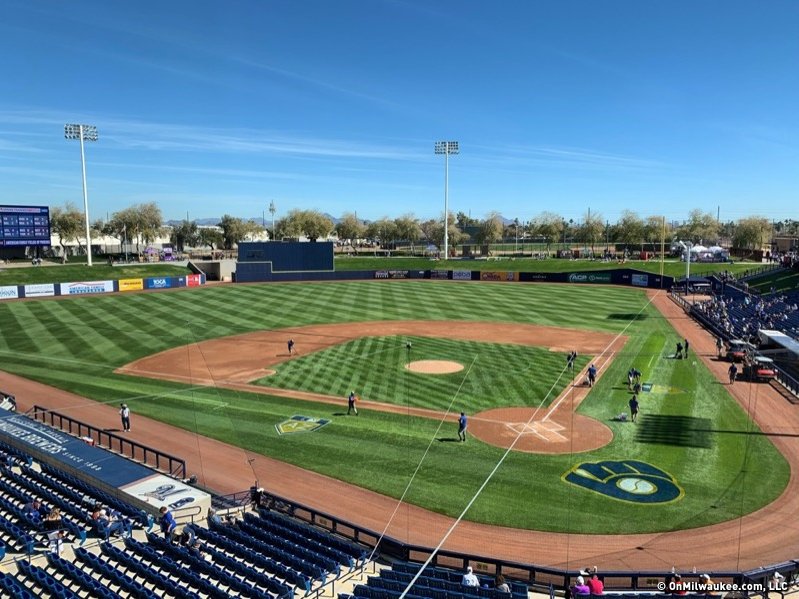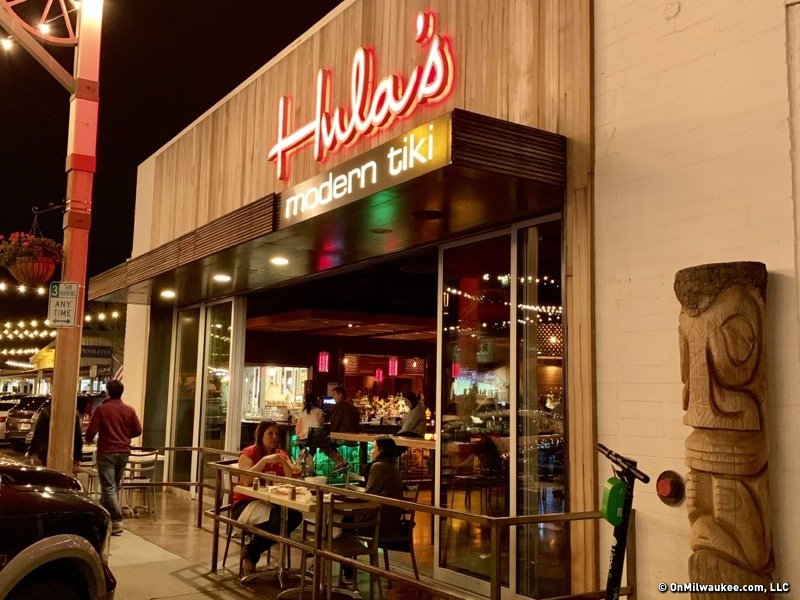"Now the children try to find it / And they can't believe their eyes." Frank Sinatra wasn't singing about Compadre Stadium, but he certainly could have been. After all, the Milwaukee Brewers former spring training home today is a far cry from its glory days, now 15 years removed from when it last played host to a baseball game.
When Compadre opened in 1986, it was the crown jewel of the Cactus League. Just 11 years later it was obsolete and abandoned. Today, it is depressingly recognizable by curious Brewers fans willing to make the drive to where they spent glorious March afternoons escaping the harsh Wisconsin winters years ago.
Compadre Stadium was built on undeveloped land by local investors in Chandler, Ariz., to replace the Brewers longtime spring training facility in Sun City, another suburb of Phoenix. Sun City had been the Brewers spring training home since 1973, but had become obsolete because all it provided was a small, outdated stadium with a sparse, cramped clubhouse facility that both teams playing that day had to share. There was a practice facility, but it was more than one mile away.
When the stadium in Sun City was sold to a developer who planned to raze the aging ballpark to make way for a housing development, the Brewers began to look around for new facility to call home for the final six weeks of winter.
Enter Jim Patterson.
Patterson was the former mayor of a small community of 65,000 residents situated about 15 miles southeast of Phoenix. At the time, Chandler consisted mostly of cacti, farms and barren fields. But the mayor-turned-land developer's vision of what his community could be included professional sports.
"One of my goals as mayor was to create community activity and give notoriety to Chandler," Patterson told the Milwaukee Sentinel in 1986. "I couldn't think of a better way to do that than to bring a major league team here."
In Chandler, the Brewers could spread out for the first time. They had one full-size practice field and another half-field where they could conduct infield drills. There were six practice mounds where pitchers could get their work in, and numerous batting cages where hitters could hone their swing. For the first time, the Brewers had their own clubhouse in their own spring facility.
The stadium was state-of-the-art and featured berms that were perfect for soaking up the sun while lying out on the grass; a luxury for traveling Wisconsinites suffering from cabin fever. Compadre was the first stadium to eschew actual seats in favor of the now-standard spring training feature.
"We're very proud of it," Patterson continued, gazing across his field of dreams on that February day a generation ago. "It's giving Chandler a lot more recognition. We're getting cards every day from people asking about it."
"This gives Chandler some identity," said Kent Mulkey, president of the Chandler Chamber of Commerce at the time the stadium opened, to the Milwaukee Sentinel. "This town is more excited about this than anything I've seen here. And we expect it to have a big impact on the local economy."
Whether it had the desired economic impact is still a matter of debate. What is not is the notoriety that the Brewers gave the then-small farming community.
"Chandler was considered the boonies and a cow town back then," lifelong Chandler resident Lex Hohan, 31, remembers today. "There was nothing out here. Fields everywhere, and smells of cows all of the time. Even at the stadium you could smell the dairy farms."
But while the new complex was getting raves despite the smell, the clubhouse almost saw an unspeakable tragedy before the first pitch was ever thrown.
On Feb. 27, 1986, a natural gas explosion in the Brewers clubhouse injured 10, including manager George Bamberger and general manager Harry Dalton. Third base coach Tony Muser was the most badly injured, with second and third-degree burns over 50 percent of his body. In fact, Muser was so badly hurt that he had to miss the entire season to recover.
Bamberger called it a "terrible explosion" at the time.
"This bolt of fire came right through the door," said Bamberger, who died in 2004. "Just like it went right through me and knocked me out of my chair. Everybody was knocked to the floor. (then-bullpen coach) Larry Haney was on the floor next to me, both arms on fire. The workman was in the doorway going out of my office and he's completely on fire with his hair and his back and everything."
The explosion marred an otherwise stellar opening to what many viewed as the best spring training facility in baseball. The accident also provides an interesting footnote in Brewers history. As Muser was recuperating from his injuries, he was replaced by Tom Trebelhorn in the third base coaching box. As the Brewers faded down the stretch and Bamberger retired again, Trebelhorn, not Muser, was tabbed to replace the aging legend.
Fortunately, no one was killed in the accident, everyone eventually recovered and the Brewers opened up their new ballpark with great fanfare. They also opened up to enthusiastic crowds.
Unfortunately, it was to be short-lived.
Chandler was a small community 26 years ago when Compadre Stadium opened. The Chandler Compadres, a local non-profit civic group operated the facility as a way to generate charitable revenue. But when the arms race of the latest and greatest began in the Cactus League in the early 1990s, Chandler decided that it was not going to try to compete.
Oh, there were fruitless talks in the mid-1990s where the Brewers asked for up to $15 million in site improvements, but there was no way Chandler residents wanted any part of that. Before long, about 30 miles away the struggling neighborhood of Maryvale was offered up by a local developer, John T. Long. After the Maricopa County Stadium District offered up $17 million for facility construction, it was a fait accompli.
But whatever became of the once-prized ballpark the Brewers left Sun City for in 1986?
Believe it or not, Compadre Stadium is still there today, or more accurately, its shell still remains. Little else has been done with the property other than the removal of seats of the grandstand. The disrepair stands in stark contrast to the jewel the stadium once was.
But to say that the stadium is just a vast wasteland would not be accurate, according to current Chandler Compadres general manager Frank Pezzorello.
"We farm it now," Pezzorello says. "There aren't any ball fields any more. It's been turned into a farming operation over the majority of the parking and field area."
Pezzorello has been a member of the Compadres since 1984 and remembers the Brewers 11-year stay there quite well. But he also is very protective of the site where legends such as Robin Yount and Paul Molitor once roamed.
"There eventually will be a resort-hotel facility," Pezzorello says. "That's what it was set aside for after the Brewers left. But that was postponed because of the economy. So we'll keep farming the land until the economy turns around and the land can be used for future development."
Of course, nowadays spring training facilities have standard features that would be the envy of any of the in-season cathedrals major league teams play in. Most clubs, the Brewers included, use their spring facilities today year-round for medical, rehab and player developmental purposes. Many clubs are said to share a facility, but that is a misnomer.
While several teams share a spring training stadium, they each have their own separate training facilities within the same complex. As a result, it is not uncommon to see an expanse of green where a dozen or so diamonds have been built where desert sand once stood.
Meanwhile, in Chandler, even though the dugouts where the best major leaguers once sat have been vandalized with graffiti, Compadre Stadium remains as a relic of a facility caught in between eras. Although it was once viewed as a sparkling palace, it just couldn't keep up with the demands of what major league teams needed and quickly fell out of favor even while it was still receiving rave reviews.
But today, even as sheep roam the outfield grass, memories of what was once a great ballpark resonate with those that were there.
"The apartments I lived in at the time housed many of the Brewers players," Hohan remembers with a smile. "I often played with their children, and met more of the players than I can remember. I have a signed card from Mark Clear, whose daughter and I were best friends that spring. We played together every day."
In Arizona and everywhere in sports today, times certainly have changed.
Doug Russell has been covering Milwaukee and Wisconsin sports for over 20 years on radio, television, magazines, and now at OnMilwaukee.com.
Over the course of his career, the Edward R. Murrow Award winner and Emmy nominee has covered the Packers in Super Bowls XXXI, XXXII and XLV, traveled to Pasadena with the Badgers for Rose Bowls, been to the Final Four with Marquette, and saw first-hand the entire Brewers playoff runs in 2008 and 2011. Doug has also covered The Masters, several PGA Championships, MLB All-Star Games, and Kentucky Derbys; the Davis Cup, the U.S. Open, and the Sugar Bowl, along with NCAA football and basketball conference championships, and for that matter just about anything else that involves a field (or court, or rink) of play.
Doug was a sports reporter and host at WTMJ-AM radio from 1996-2000, before taking his radio skills to national syndication at Sporting News Radio from 2000-2007. From 2007-2011, he hosted his own morning radio sports show back here in Milwaukee, before returning to the national scene at Yahoo! Sports Radio last July. Doug's written work has also been featured in The Sporting News, Milwaukee Magazine, Inside Wisconsin Sports, and Brewers GameDay.
Doug and his wife, Erika, split their time between their residences in Pewaukee and Houston, TX.







